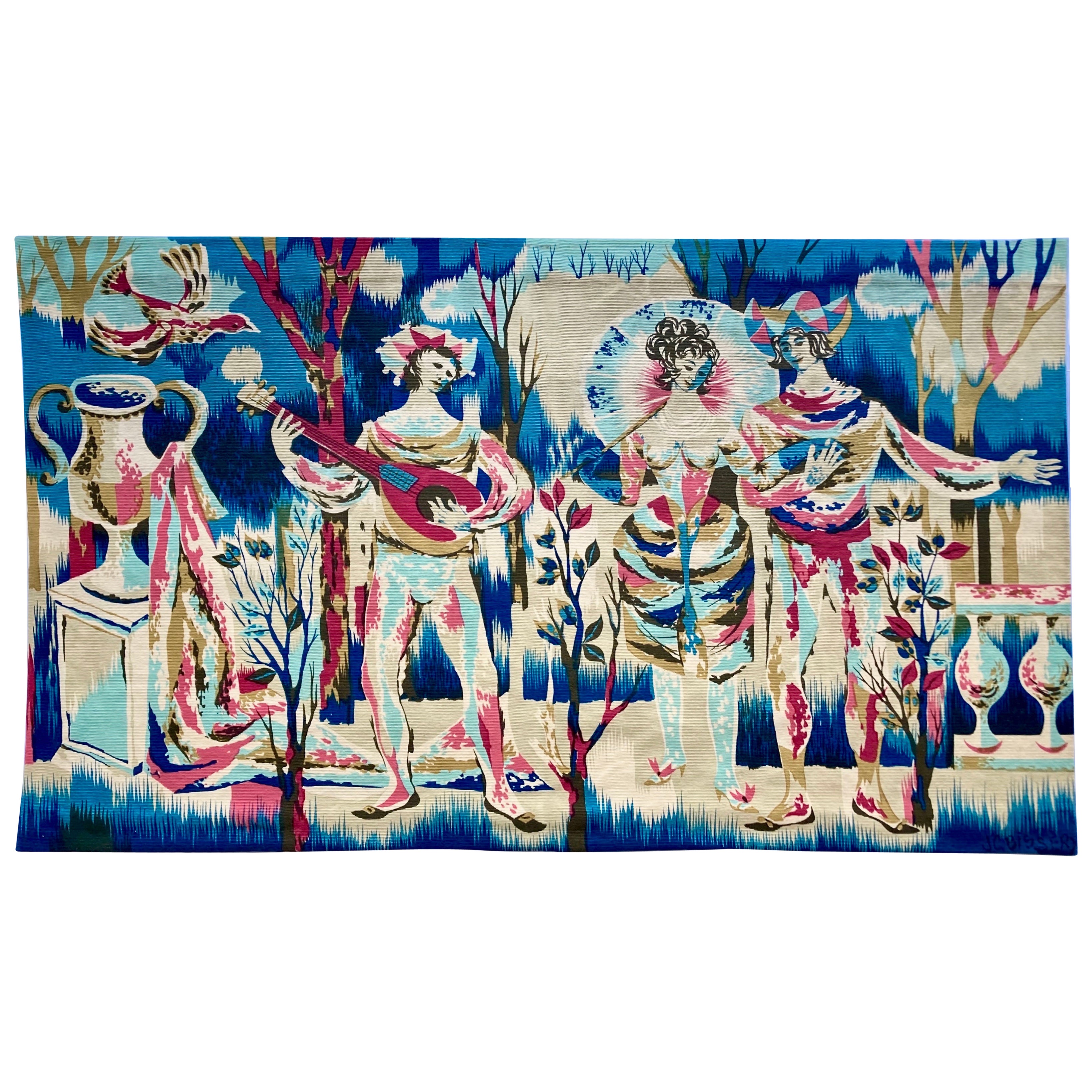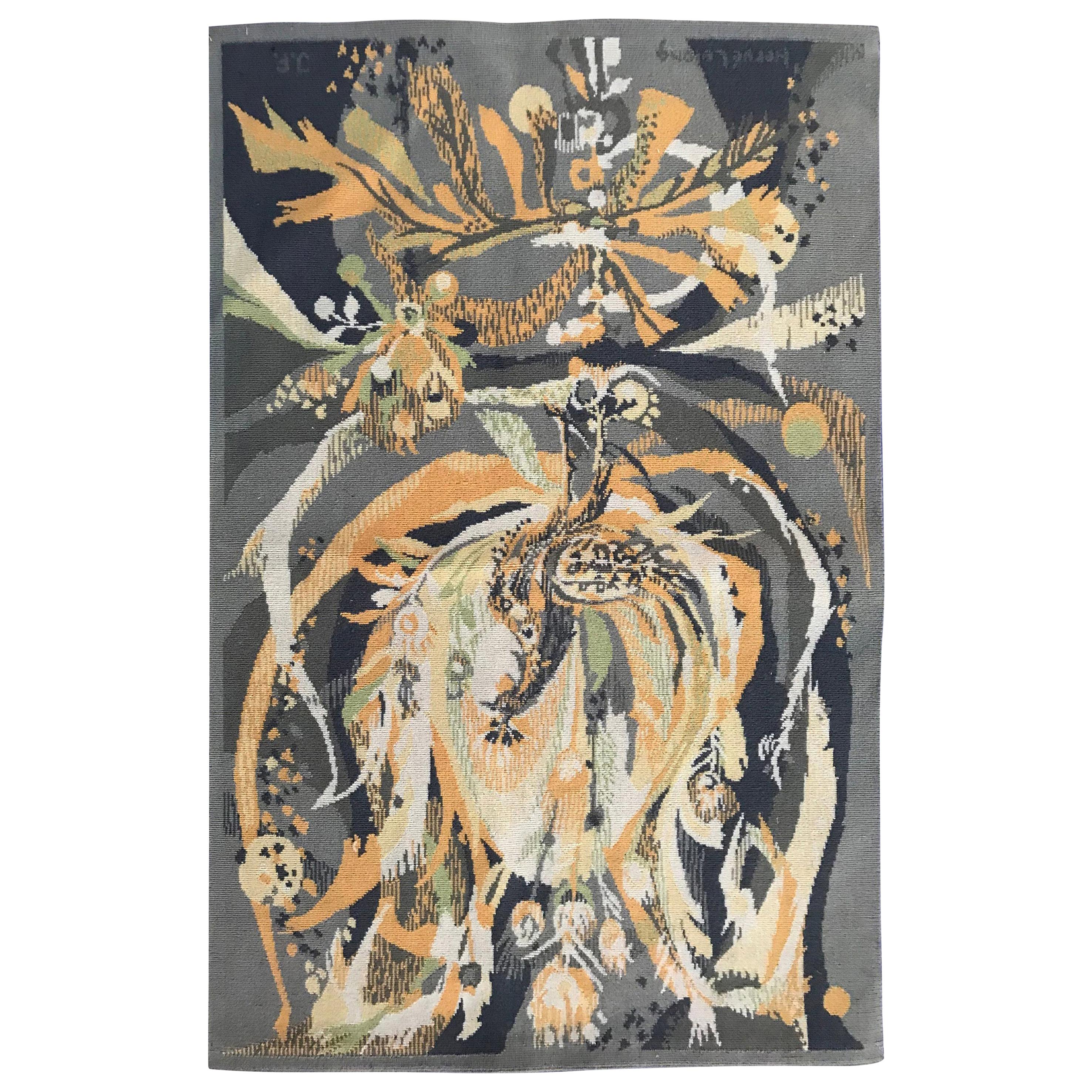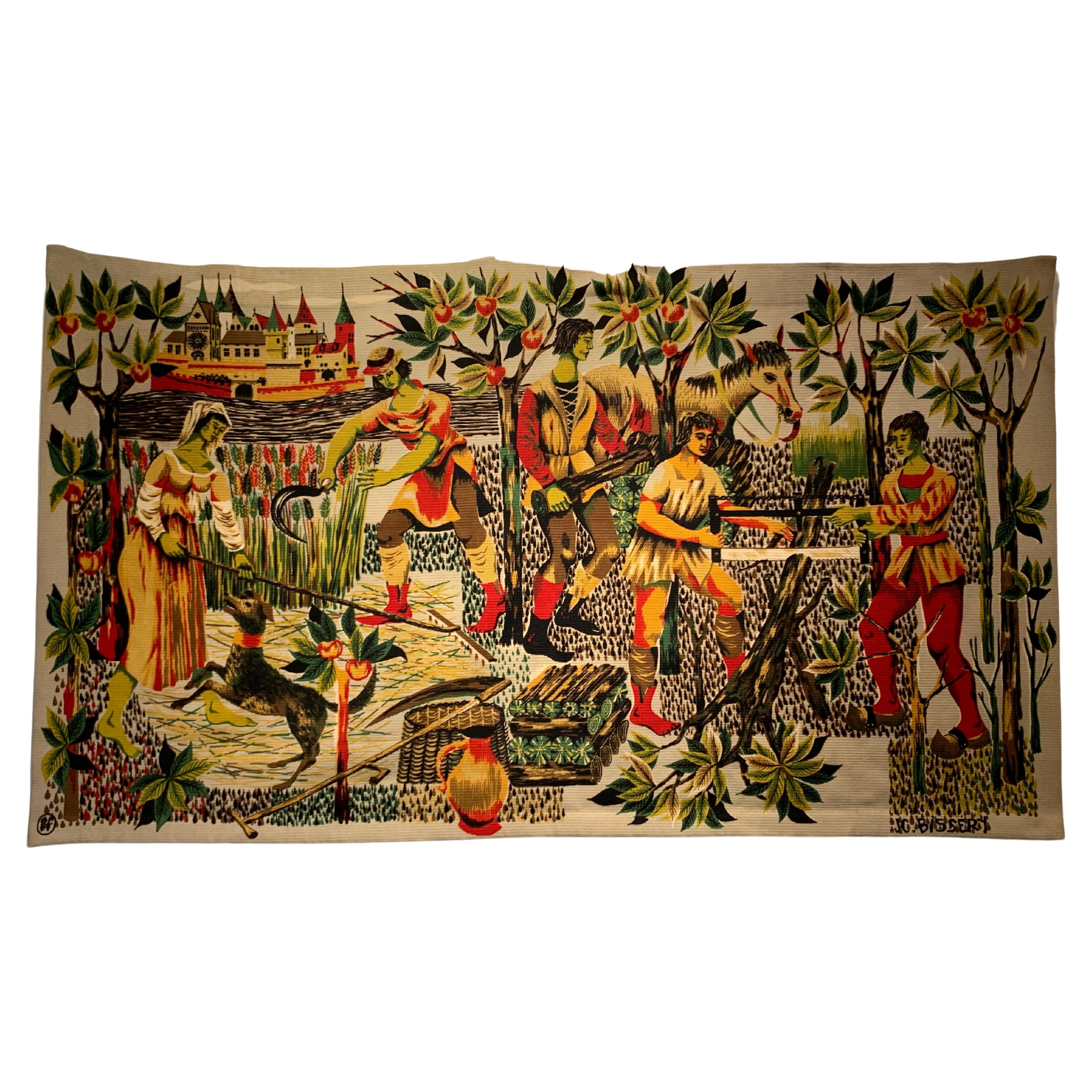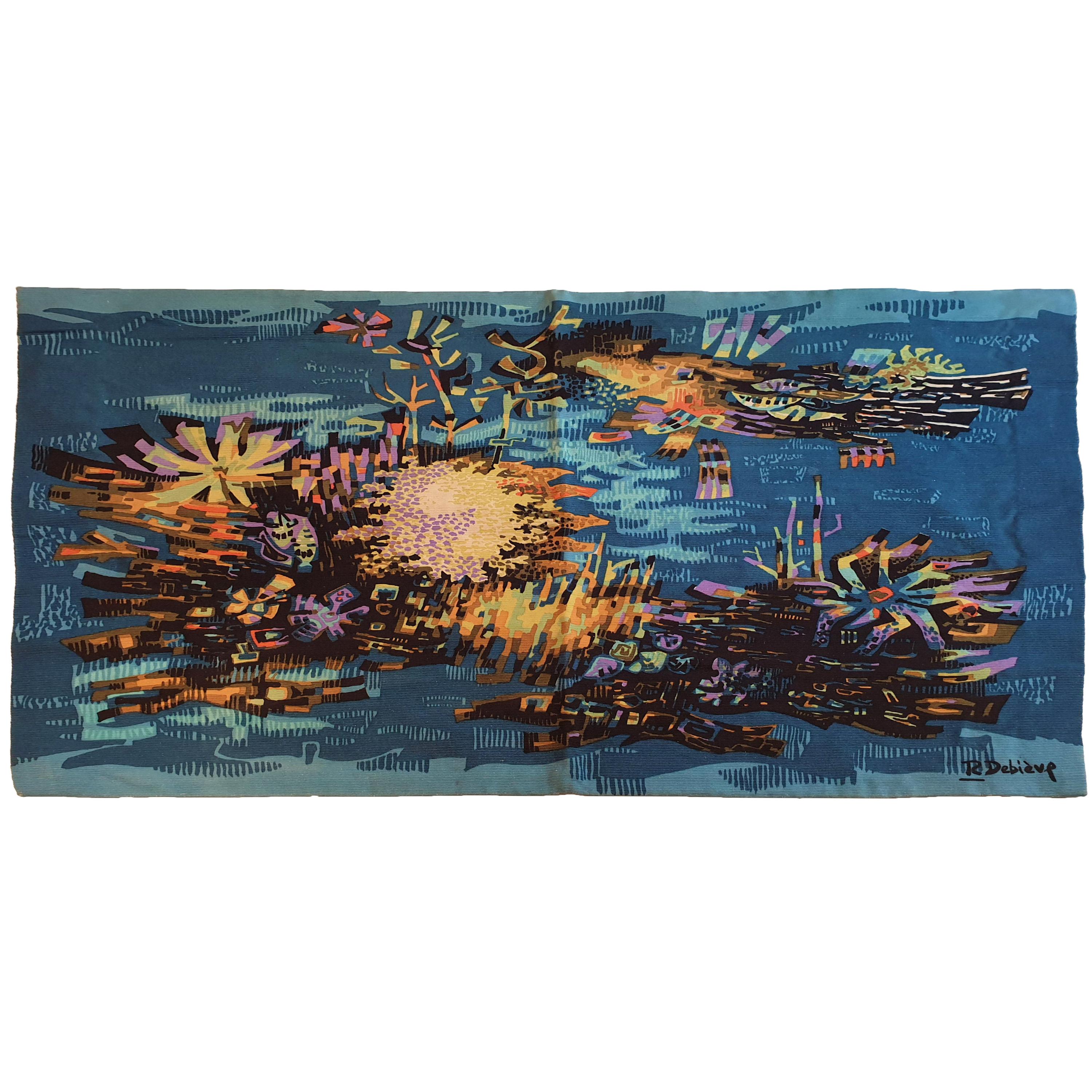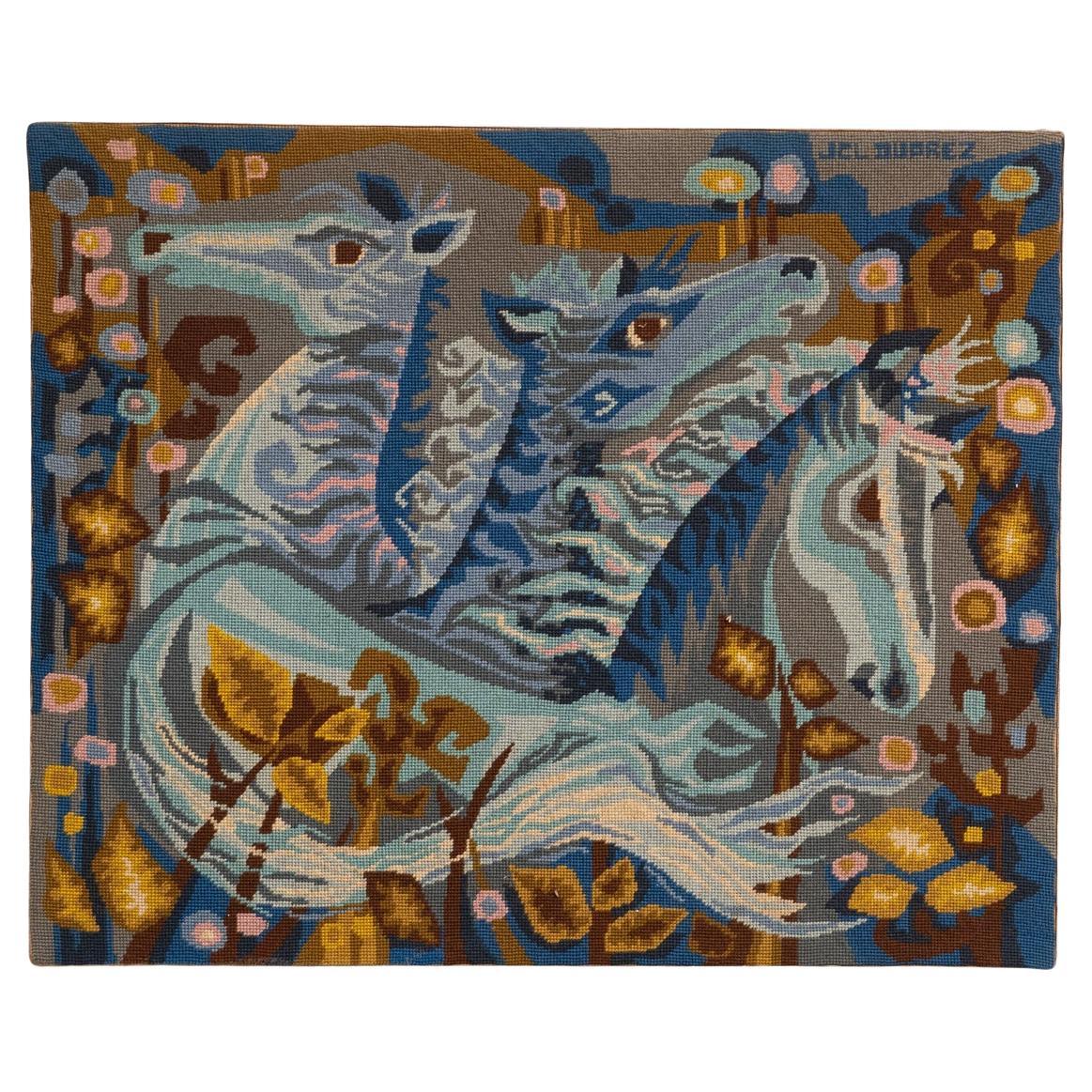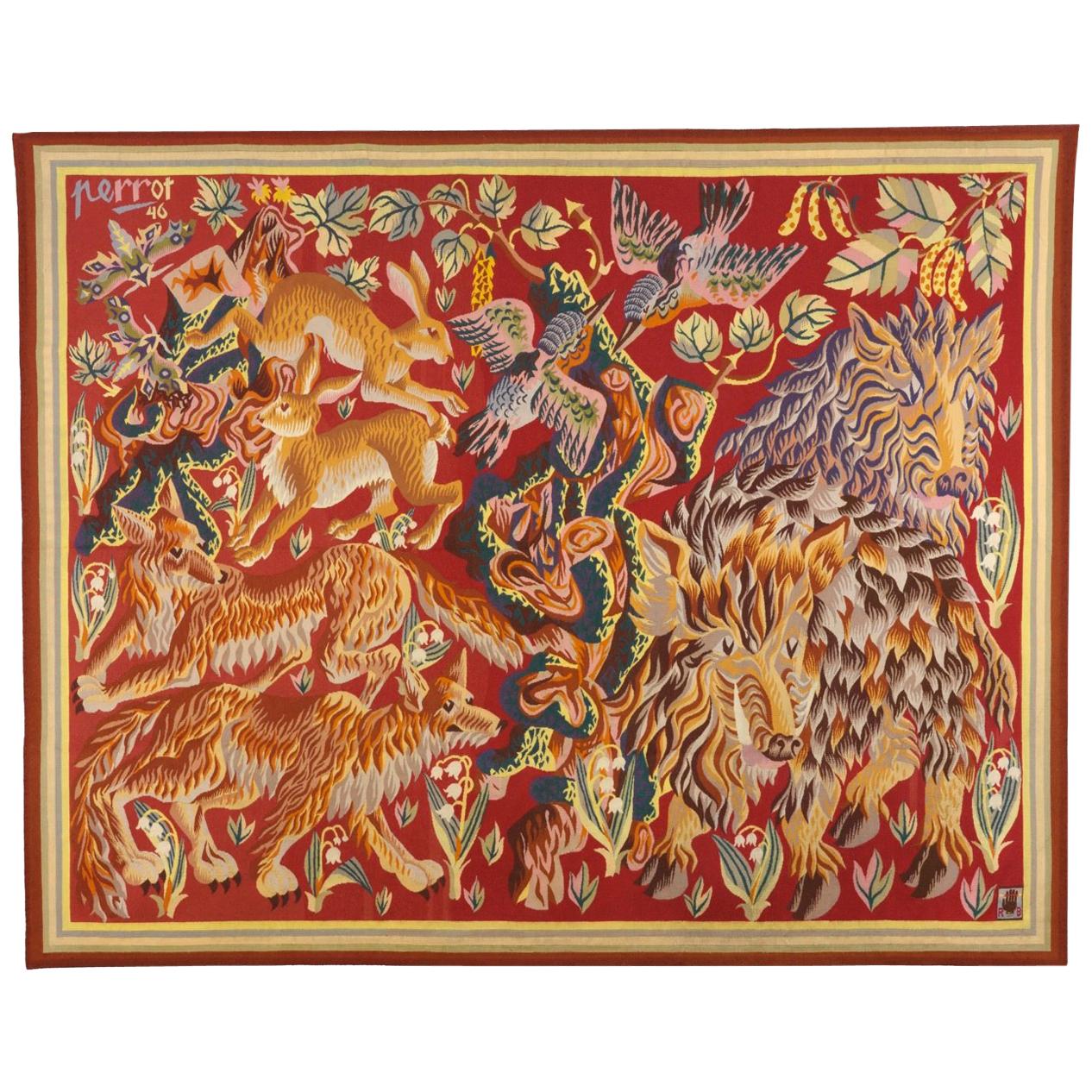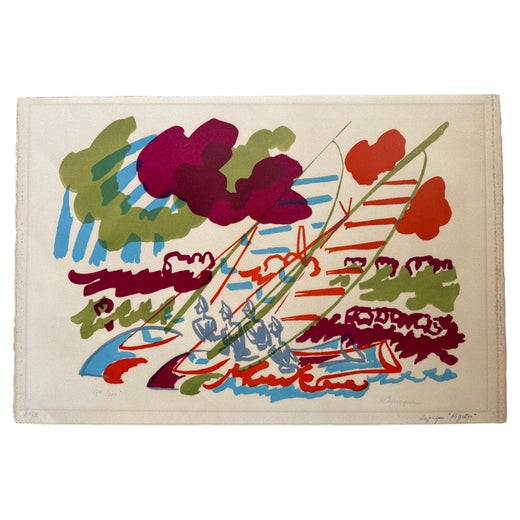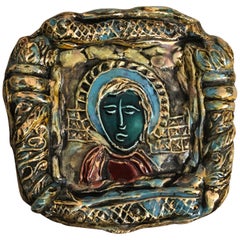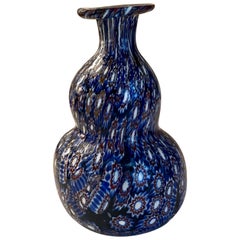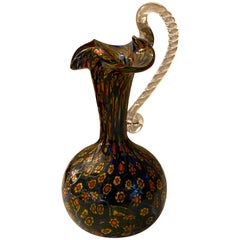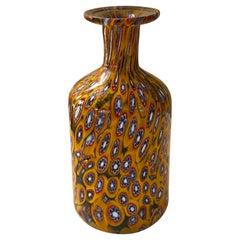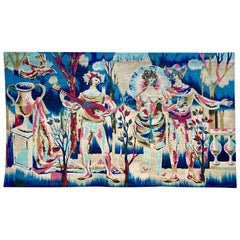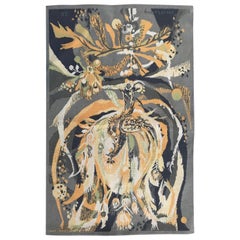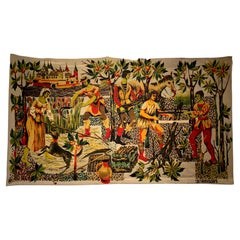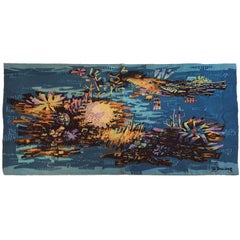Items Similar to French Artist Charles Lapicque Tapestry Limited Edition 1/2 "Pelops", 1964
Want more images or videos?
Request additional images or videos from the seller
1 of 18
French Artist Charles Lapicque Tapestry Limited Edition 1/2 "Pelops", 1964
$42,993.53
£31,769.64
€36,000
CA$59,558.46
A$65,099.56
CHF 34,286.35
MX$800,461.62
NOK 428,485
SEK 403,119.80
DKK 274,137.45
About the Item
Exceptional limited edition 1/2 tapestry "Pelops" with certificate from a private collection,
1964.
Ateliers Pinton brothers in Felletin, under the supervision of Pierre Baudouin
2ex + 1EA Editor Aram Iynedjian. The tapestry will be sold with its certificate of authenticity from the gallery.
From the 15th century, the name of Pinton was associated with the Aubusson tapestry. Since then, over the generations, the Pinton family has largely contributed to the development of this fabulous cultural heritage until the creation in the 19th century, of the Felletin factory, in the department of Creuse. Even today, in these workshops, the craftsmen execute the same correct gestures with the same attention to detail and thus extend the chain of the history of the tapestry of tradition but also contemporary. The hand of specialists, the eye of designers and dyers and the taste of the most demanding clientele find their meaning in the fabric of the carpets. The excellence of French know-how, a living heritage society and custodian of Aubusson's cultural heritage, has always collaborated with great artists. The works of Charles Le Brun, Charles Lapicque, Pablo Picasso, Jean-Michel Othoniel, and many other big names in the world of painting, architecture, design, fell into the looms and know-how ancestral of this unique Creuse creator.
Editor Aram Iynedjian
Aram Iynedjian, Lausanne gallery owner and editor of tapestries from Braque, Estève and Lapicque, the latter meets Pierre Baudouin, the most famous of the cardboard painters of the time. The one who translated the works of Le Corbusier, Calder or Picasso into tapestry then collaborates with Charles Lapicque and they will develop a work of great richness.
Lapicque came to realize these two summits which are "Pélops" and "Diane et Actéon".
I realize that you should never try to describe a work of art
Let’s look at it. Let us admire the science of composition, linear purity, technical perfection, the beauty of color, the truth of the drama. Let us see, if we can, the implacable presence of genius.
"We will now understand that after having based a painting on the love of tapestry, it was relatively easy, and very tempting, to build a tapestry faithful to my painting," explained the artist in the exhibition catalog. of the Galerie Verrière in 1970. It was not until 1961 that he began to produce cardboards both for the tapestry of the Lisse in Aubusson, but also at the Mobilier National, with the help of Pierre Baudouin
Charles Lapicque (1898-1988)
Born in 1898 in Theizé (Rhône) in a family practicing both the arts and the sciences, Charles Lapicque is no exception to the rule: gifted for music and drawing, he graduated from the École Centrale in 1921, works as engineer until 1928 before integrating in 1931 a laboratory at the Faculty of Sciences of Paris, where he carried out research on the perception of colors, crowned by the title of Doctor of Physical Sciences in 1938. He thus studies the reactions of the eye in front of an intense light source, at the origin of the formation of starry images which he will use in his works, and defines a theory of the staggering of colors in space which overturns the rules of the Renaissance: "I had shown that the Classic rule, that of Vinci, advocating placing the blues in the distance, the reds, oranges and yellows in the foreground, is
a nonsense; it makes more sense, more favorable to do the opposite. "(In Red and blue in the arts, 1936)
It was around 1920 that Charles Lapicque began to paint in Brittany where he spent every summer since his childhood, first on the motif and then in a workshop that his stepfather Jean Perrin, Nobel Prize in Physics, had him build in 1927 ; he then definitively adopted the work of memory, in accordance with the art of music which he deeply loved and the Bergsonian philosophy of knowledge: "It is up to us to give reality an appearance that it has no itself, a form, a figure (...). "
His youthful production immediately reveals a great originality, oscillating between figuration and abstraction which sometimes intertwine: alongside synthetic paintings by their simplified drawing and their flat colors, he designs an Homage to Palestrina (1925), composed of a grid derived from Cubism, entirely abstract, relayed by a Christ with Thorns (1939), according to a principle that he will develop after 1939, in line with his optical discoveries. In fact, during the war years, an almost abstract period began, that of the tight blue framework, applied to backgrounds ranging from yellow to red and revealing a more or less identifiable world (Jeanne d'Arc crossing the Loire, 1940; Rencontres series, 1940-1945). Exhibited in 1929 by the gallery owner Jeanne Bucher, Lapicque abandoned his scientific career in 1943 to devote himself entirely to painting.
He continued his work which resulted in 1946-1953 in white-frame structures; their much softer lines lead him to the system of
either black or white interlacing which encloses areas of pure color, most often in solid color. With The Battle of Waterloo in 1949, Lapicque still uses optics - zooming in on a given area - to depict spaces with multiple perspectives and decomposed times.
This new interest in the liveliness of color developed in the following period, which can be described as flamboyant or Baroque (1954-1963): illustrated in particular by the series of Breton lagoons and twilight or nocturnal views of Venice in the light. Stars, which the artist himself describes as “daring sweets”, it begins with the Raoul Dufy Prize of the Venice Biennale, awarded in 1953 to the artist who took the opportunity to give free rein to his passion for the Serenissima until July 1956.
Another point in common with his elder brother is the expression of movement. Begun in 1949 in The Battle of Waterloo then in 1952 with Dimanche aux regates, it became an obsession from 1964, in the exploration of new themes, such as the different shots of tennis players captured on the fly (1965), the mythological scenes and sea storms.
These dizzying years precede the artist's last period: as he comes of age, he discovers serenity, revealed by a painting now with acrylic paint, much more peaceful from 1974, which even borders on a childish naivety at the end. of his life.
All of his work includes an astonishing diversity of themes, also nourished by his travels (Rome in 1957, Greece in 1964, Holland in 1974 ...), with a predilection for the sea, rocks, sailboats, music, tennis, horses, wild beasts, but also for history and mythology, as evidenced by knights, kings and ancient gods. It also deploys, in total creative freedom, a wide variety of styles and orientations. Having been one of the pioneers of non-figurative art, thus paving the way for artists like Manessier, Bazaine, Vieira da Silva, De Staël, etc. Owners of the new non-figurative Paris School of the Postwar period, Charles Lapicque then returned to figuration, in a "new interpretation" of appearance, even if he continued to rub shoulders with abstraction at times.
"Drawing runs after color and color after drawing. "
Heir to the Fauves, Charles Lapicque plays like them on pure colors, whose dissonances, associated with a totally free design and an overloaded composition in a multiple space, make him a precursor of the New Figuration in all its forms: the Narrative Figuration born in France in the early 1960s, represented in particular by Gérard Fromanger, Erró, Bernard Rancillac and Gérard Guyomard; Free Figuration born in the early 1980s, marked by Robert Combas, Hervé and Richard Di Rosa, Louis Jammes and François Boisrond, and which, in turn, influenced the American Bad Painting of a Jean-Michel Basquiat or a Keith Haring, deliberately neglected and Expressionist; Lapicque's “Classic subjects” were able to feed Cultivated Painting, which also appeared in the early 1980s with Jean-Michel Alberola, Patrice Giorda and Gérard Garouste, while the violence of its color foreshadows the New Fauves
German and Austrian like Georg Baselitz and A.R. Penck. And it also seems obvious the influence of Lapicque's black interlacing on Jean-Michel Atlan's African entities, like the way opened by the Lapicquian white frameworks in the Jean Dubuffet's Hourloupe cycle, which appeared in 1962.
His works are now preserved in a number of French public collections, notably at the National Museum of Modern Art in Paris and at the Museum of Fine Arts in Dijon (Granville donation) but also in Besançon, Grenoble and Nantes, as well as in Europe (Brussels, Copenhagen, Essen, Munich, Stuttgart) and in North America (New York, Ottawa, Toronto).
some important dates:
War Cross 1914-1918, 1989-1953-1956: Receives the Raoul Dufy Prize from the Venice Biennale, a travel grant in this city where he will make four stays between 1953 and 1955. Named Knight of the Legion of Honor (1953). Many paintings inspired by Venice and the Veneto (1954-1956), followed by a series of Breton landscapes on the coast of Armor (1956).
Philately: issue in homage to Charles Lapicque of a French postage stamp reproducing Régates vent après (1952), 1989
1966: Officer of the Legion of Honor. Commander of Arts and Letters. Receives the National Grand Prize for Painting (1979).
1988: Charles Lapicque dies in Orsay on July 15 when a tribute is paid to him with five major works during the collective exhibition "The 1950s" at the Center Georges Pompidou. (Daniel Abadie, exhibition curator; Germain Viatte, director).
The Museum of Fine Arts in Dijon has since 1974, following a donation from Pierre and Katheen Granville, 45 paintings and 31 drawings by Charles Lapicque permanently exhibited including Tigers, Venice, seas or mythologies;
that the Museum of Fine Arts & Archeology of Besançon published a work by Hazan "Charles Lapicque in Besaçon" following a donation by Norbert Ducrot-Granderye in 2011 from a large collection of works by Charles Lapicque;
that the Museum of Art & History of the Grand Duchy of Luxembourg permanently exhibits ten important works by Charles Lapicque,
that Beaubourg has 12 paintings and nearly 200 drawings since 1978: and more.
International museums with works by Lapicus:
Museum of Modern Art, New York,
Gallery of living Art, New York
Kansas City Baltimore Museum (1952)
Bayerische Staätsgemäldesammlung, Munich
Copenhagen Museum
California Palace of The Legion of Honor, San Francisco,
National Museum of Modern Art in Paris (1967)
National Museum of History and Art, Grand Duchy of Luxembourg;
Royal Museums of Fine Arts of Belgium;
Folkwang Museum, Essen Museum, Germany;
Lenbachhaus Museum (Städtische Galerie im Lenbachhaus), Munich, Germany
Copenhagen Museum, Statens Museum for Kunst (National Art Museum), Denmark
Staatsgalerie (state gallery) Stuttgart, Germany
Museum of Modern Art, New York,
Toronto Museum,
Museum of the Athenaeum, Geneva
Ottawa Museum,
The European museums which exhibited, "L’orage sur Lanmodez 1948", during retrospectives of Lapicque's work, are:
The Kunsthalle in Bern and the Städtische Galerie in Munich in 1962
The Städtisches Museum Trier (Museum of the city of Trier) in 1963 exhibited a comparable work entitled Landscape on the bay 1948, 92 x 60cm (same pictorial approach as the storm on Lanmodez)
Retrospectives, special exhibitions in museums:
Exhibitions organized by the Louis Carré gallery in New York, Chicago, Philadelphia (1951)
Retrospectives (1960) New York, Albert Loeb Gallery
Lapicque in the collections of European National Museums:
1960, Museum of Nantes,
1962, Kunsthalle Bern, Städtische Galerie Munich
1962 Museum of Grenoble,
1962 Le Havre Museum,
1964 Kunstverein, Hamburg
1965 Museum Folkwang, Essen
1967 National Museum of Modern Art in Paris
1967 Kunstamt-Tempelhof, Berlin
1969 Brest Museum
1970 Toulouse-Lautrec Museum, Albi.
- Creator:Charles Lapicque (Artist)
- Dimensions:Height: 86.62 in (220 cm)Width: 104.34 in (265 cm)Depth: 0.2 in (5 mm)
- Materials and Techniques:Wool,Woven
- Place of Origin:
- Period:
- Date of Manufacture:1964
- Condition:The tapestry is in excellent vintage condition, no holes or tears. If you need additional photos or a video do not hesitate to ask us. The tapestry will be sold with its certificate of authenticity signed by the granddaughter of Charles Lapicque.
- Seller Location:Paris, FR
- Reference Number:1stDibs: LU4817219635792
Charles Lapicque
Charles Lapicque (1898-1988) was a French painter and printmaker known for his significant contributions to the art world, particularly in the realm of abstraction. Lapicque's work evolved over time, beginning with figurative painting and eventually transitioning towards a more abstract and geometric style influenced by Cubism and Futurism. Key aspects of Lapicque's art include his use of vivid colors, dynamic compositions, and a sense of movement that often characterizes his paintings. He was also known for his experiments with light and shadow, creating works that play with perception and spatial relationships.
About the Seller
5.0
Vetted Professional Seller
Every seller passes strict standards for authenticity and reliability
Established in 2017
1stDibs seller since 2019
57 sales on 1stDibs
Typical response time: 8 hours
- ShippingRetrieving quote...Shipping from: Paris, France
- Return Policy
Authenticity Guarantee
In the unlikely event there’s an issue with an item’s authenticity, contact us within 1 year for a full refund. DetailsMoney-Back Guarantee
If your item is not as described, is damaged in transit, or does not arrive, contact us within 7 days for a full refund. Details24-Hour Cancellation
You have a 24-hour grace period in which to reconsider your purchase, with no questions asked.Vetted Professional Sellers
Our world-class sellers must adhere to strict standards for service and quality, maintaining the integrity of our listings.Price-Match Guarantee
If you find that a seller listed the same item for a lower price elsewhere, we’ll match it.Trusted Global Delivery
Our best-in-class carrier network provides specialized shipping options worldwide, including custom delivery.More From This Seller
View AllMarc Roussel French Ceramist, Saint Portrait, Vallauris, 1960s
By Marc Roussel
Located in Paris, France
A very rare and beautiful portrait of a Saint, a polychrome ceramic signed hand on the reverse Marc Roussel.
Marc Roussel is the father in Law of François Lembo, as his son-in-law h...
Category
Early 20th Century French Contemporary Art
Materials
Ceramic
Collectable vintage Fratelli Toso Murano Murrine Millefiori, Art Glass Vase
By Fratelli Toso
Located in Paris, France
Lapis lazuli blue colour vintage Fratelli Toso Murano Millefiori. Murrine is an ancestral technique in Murano glass. Each piece of Murano glass is handmade, not mass-produced or industrialized.
It takes a lot of patience and know-how to make Murrine. The placement of the murrine has been done with great care and precision by Murano craftsmen. This work is unique in the world for its combination of color and elegance.
Fratelli Toso was founded in 1854 by the brothers Ferdinando, Carlo, Liberato, Angelo, Giovanni and Gregorio. At the beginning the company produced pharmaceutical containers and domestic glassware. A vibrant and intricate decorative piece for any space. Collectible piece in a range of different styles, shapes, and sizes. Hand blown multicolor Murano glass made in Italy in the early 20th century. The glass masters of Fratelli Toso have over 150 years of experience, taking from ancient Italian glassmaking techniques. Royal blue vase...
Category
Early 20th Century Vases
Materials
Art Glass
Collectable Fratelli Toso Murano Murrine Millefiori, Amphora Art Glass Vase
By Fratelli Toso
Located in Paris, France
Very raffinated deep blue saphir colour, vintage Fratelli Toso Murano Millefiori. Murrine is an ancestral technique in Murano glass. Each piece of Murano glass is handmade, not mass-produced or industrialized.
It takes a lot of patience and know-how to make Murrine. The placement of the murrine has been done with great care and precision by Murano craftsmen. This work is unique in the world for its combination of color and elegance.
Fratelli Toso was founded in 1854 by the brothers Ferdinando, Carlo, Liberato, Angelo, Giovanni and Gregorio. At the beginning the company produced pharmaceutical containers and domestic glassware. A vibrant and intricate decorative piece for any space. Collectible piece in a range of different styles, shapes, and sizes. Hand blown multicolor Murano glass made in Italy in the early 20th century. The glass masters of Fratelli Toso have over 150 years of experience, taking from ancient Italian glassmaking techniques. Royal blue vase...
Category
Early 20th Century European Vases
Materials
Art Glass, Murano Glass
Collectable Vintage Fratelli Toso Murano Murrine Millefiori, Art Glass Vase
Located in Paris, France
Murrine is an ancestral technique in Murano glass. Each piece of Murano glass is handmade, not mass-produced or industrialized.
It takes a lot of patience and know-how to make Murrine. The placement of the murrine has been done with great care and precision by Murano craftsmen. This work is unique in the world for its combination of color and elegance.
Fratelli Toso was founded in 1854 by the brothers Ferdinando, Carlo, Liberato, Angelo, Giovanni and Gregorio. At the beginning the company produced pharmaceutical containers and domestic glassware. A vibrant and intricate decorative piece for any space...
Category
Mid-20th Century Vases
Materials
Art Glass
Collectable vintage Fratelli Toso Murano Murrine Millefiori, Art Glass Vase
By Fratelli Toso
Located in Paris, France
Red rubis vintage Fratelli Toso Murano Murrine Millefiori. Murrine is an ancestral technique in Murano glass. Each piece of Murano glass is handmade...
Category
Early 20th Century European Vases
Materials
Art Glass
Collectable Vintage Carlo Scarpa Murano Murrine Millefiori, Glass Vase Amphora
By Carlo Scarpa, Venini
Located in Paris, France
Vintage small vase green, burgundy and white runoff inlay in a form of amphora, design Carlo Scarpa Fratelli Toso Murano Murrine Millefiori. Murrine...
Category
Mid-20th Century Vases
Materials
Art Glass, Murano Glass
You May Also Like
Vintage 1960s Hand-Printed French Wall Tapestry in Wool Signed by J.C. Bissery
By Jean Claude Bissery
Located in COLMAR, FR
An exceptional and very rare wall tapestry from the 1960s in amazing condition. This large and stunning wall tapestry in wool has been designed and signed on the back by the French a...
Category
Vintage 1960s French Modern Tapestries
Materials
Wool
Modern French Tapestry Attribute to Hervé Lelong
By Hervé Lelong
Located in Saint Ouen, FR
Beautiful tapestry from 20th century with a modern design with signature of artist Hervé Lelong, machine made with wool velvet.
Category
Mid-20th Century French Art Deco Tapestries
Materials
Wool
Mid-Century tapestry “Moyen-Âge”signed by Jean-Claude Bissery
By Jean Claude Bissery
Located in Beirut, LB
Mid- 20th Century Tapestry “Moyen-Age”signed by Jean-Claude Bissery.
Entitled "Moyen Age" depicting a medieval scene with foresters at work.
Jean Claude Bissery is a French Postwar &...
Category
Vintage 1960s French Post-Modern Tapestries
Materials
Wool
772 -Tapestry Robert Debieve of the 20th Century
By Royal Manufacture of Aubusson
Located in Paris, FR
"Sub-Marine" modern tapestry of the 20th century realised by Robert Debieve, in perfect condition of conservation.
Negotiable price and free delivery.
Dimension: 157 cm x 113 cm.
Category
Vintage 1970s French Mid-Century Modern Tapestries
Materials
Wool
Jean Claude Duprez Vintage Tapestry "Les Chevaux d’Azur", circa 1960
By Jean-Claude Duprez
Located in Barcelona, Barcelona
This stunning French tapestry, titled "Les Chevaux d’Azur," was created by Jean Claude Duprez for the Atelier d’Art Contemporain la Lice, under the direction of the acclaimed Jean Pi...
Category
Vintage 1960s French Mid-Century Modern Tapestries
Materials
Wool
Rene Perrot Aubusson Tapestry
Located in New York, NY
Midcentury tapestry designed by Rene Perrot 91912-1979) and woven at Atelier Riviere des Borderies in Aubusson, France. Handwoven in wool, it dates to 1946...
Category
Mid-20th Century French Mid-Century Modern Tapestries
Materials
Wool, Tapestry
More Ways To Browse
In The Style Of Basquiat
Tapestry Limited Edition
Calder Tapestry
Picasso Tapestry
Le Corbusier Tapestry
Jean Perrin
Tapestry Sampler
Tapestry Runner
Tapestry Netherlands
Needlework Tapestry
Tree Tapestry
Uzbek Suzani Tapestry
Hunting Tapestry
Square Tapestry
Pre Columbian Textile
15th Century Tapestry
Beauvais Tapestry
Embroidered Wall Panels
